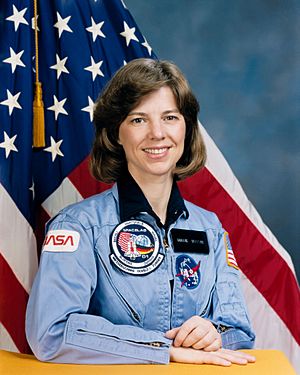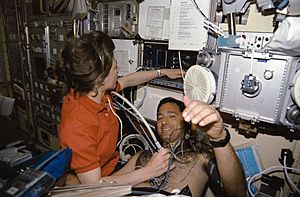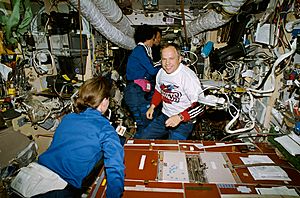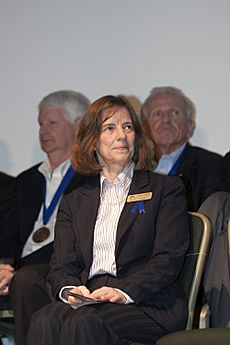Bonnie J. Dunbar facts for kids
Quick facts for kids
Bonnie J. Dunbar
|
|
|---|---|
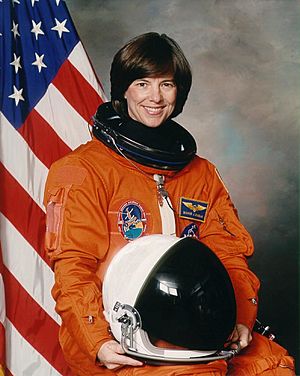
Dunbar in 1997
|
|
| Born |
Bonnie Jeanne Dunbar
March 3, 1949 Sunnyside, Washington, U.S.
|
| Space career | |
| NASA astronaut | |
|
Time in space
|
50d 8h 24m |
| Selection | NASA Group 9 (1980) |
| Missions | STS-61-A STS-32 STS-50 STS-71 STS-89 |
|
Mission insignia
|
|
| Scientific career | |
| Fields | Aerospace engineering |
| Institutions |
|
| Thesis | Effects of Antiorthostatic Kinesia on Sprague Dawley Rat Femur Fracture Toughness and Concomitant Alterations in Metabolic Activity ProQuest 303164294 (1983) |
Bonnie Jeanne Dunbar (born March 3, 1949) is an American engineer and a former NASA astronaut. She flew on five Space Shuttle missions between 1985 and 1998. These missions included two times when her shuttle connected with the Mir space station.
Bonnie Dunbar studied at the University of Washington. There, she earned a master's degree in ceramics engineering. She then worked as a senior research engineer at Rockwell International. She helped design the special ceramic tiles used to protect the Space Shuttle from extreme heat. In 1978, she joined NASA as a flight controller. She helped guide Skylab as it returned to Earth in 1979. In 1980, she was chosen to become an astronaut. She traveled to space five times on missions STS-61-A, STS-32, STS-50, STS-71, and STS-89. She even trained in Russia to be a cosmonaut.
After leaving NASA, Dunbar became the head of the Museum of Flight in Seattle. There, she worked to improve science, technology, engineering, and mathematics (STEM) education for high school students. She later taught at the University of Houston and Texas A&M University.
Contents
Early Life and Education
Growing Up on a Farm
Bonnie Jeanne Dunbar was born on March 3, 1949, in Sunnyside, Washington. She was the oldest of four children. Her father was a veteran who bought a farm in Outlook, Washington. Bonnie grew up on this farm. She learned to drive a tractor when she was about nine years old. She also helped her father fix tractors.
When she was young, girls were not allowed in the Future Farmers of America club. So, her father started a 4-H club for her. She showed cattle until she was eighteen. She was the only girl in the club.
Dreaming of Space
In 1957, Bonnie and her parents looked for Sputnik in the night sky. Sputnik was the first artificial satellite. This made her very interested in space. She read science fiction books by authors like H. G. Wells and Jules Verne. She also followed the real-life adventures of the first American astronauts, the Mercury Seven. In 1962, her family visited the Seattle World's Fair. It had an imaginary space ride and the famous Space Needle.
School Days and Career Advice
Bonnie went to a small school called Outlook Elementary. When she told her principal she wanted to build spacecraft, he told her to learn algebra. She then went to Sunnyside High School. There, she took many science and math classes, including physics and chemistry. She was also in clubs like the math club and debate club.
Her high school counselor suggested she should marry a farmer. But Bonnie ignored this advice. She asked her physics teacher for career guidance instead. She scored very well on her SAT tests, especially in spatial ability and English. Boys with similar scores were often guided toward science and engineering. However, these fields were not usually suggested for girls at that time.
College Journey
After high school in 1967, Bonnie wanted to go to top engineering schools like California Institute of Technology or Massachusetts Institute of Technology. Many astronauts had gone there. But Caltech did not accept women yet, and MIT was too expensive. She was accepted by the University of Washington. They also offered her financial help. She was the first in her family to attend college.
Bonnie was interested in poetry, but she still wanted to build spacecraft. Her physics teacher advised her to study engineering. At the University of Washington, she took many classes. She also joined the Engineering Student Council. She worked as a waitress to help pay for school.
The dean of the ceramics engineering department, James I. Mueller, heard about her interest in space. He had a grant from NASA to develop ceramic tiles for the Space Shuttle. He convinced her to switch her major to ceramic engineering. During summer breaks, she helped his team study materials for these tiles. She earned her Bachelor of Science degree in ceramic engineering in 1971.
Graduate Studies and Early Career
Finding engineering jobs was tough in 1971. So, Bonnie first worked as an office manager. Two months later, she got a job at Boeing in their computer services division. She used her skills in computer programming.
After a year and a half, her former dean, Mueller, called her. He had a new grant from NASA and asked if she wanted to go to graduate school. This project involved studying materials for batteries. She earned her Master of Science degree in ceramics engineering from the University of Washington in 1975.
In 1975, Dunbar was invited to do research in England. She studied how liquids stick to solid surfaces. Before leaving for England, she accepted a job at Rockwell International in California. She started there in October 1976. Her job was to develop the tools and methods to make the Space Shuttle's heat-shielding tiles. She was named Rockwell's Engineer of the Year in 1978 for her work on these tiles.
NASA Career
Becoming a Flight Controller
On July 8, 1976, NASA asked people to apply to be pilots and mission specialists. For the first time, women were encouraged to apply. Bonnie Dunbar was one of over 8,000 applicants. She was chosen as one of 200 finalists. In October 1977, she went to the Johnson Space Center (JSC) in Houston, Texas, for interviews. She was not chosen as an astronaut that time.
However, NASA offered her another job at JSC. Her boss at Rockwell told her to take it. In July 1978, Dunbar joined NASA as a flight controller. She helped guide Skylab as it re-entered Earth's atmosphere in July 1979. After that, she prepared for the first Space Shuttle mission, STS-1.
Bonnie noticed that most women chosen as astronauts had advanced degrees. So, she decided to earn a Ph.D. in engineering at the University of Houston. Her research involved studying how microgravity affects bones. She earned her doctorate in 1983.
Becoming an Astronaut
On August 1, 1979, NASA announced another chance to become an astronaut candidate. Over 3,000 people applied. Bonnie was a finalist again. This time, she was chosen! Her selection as one of 19 new astronaut candidates was announced on May 29, 1980.
After a year of training, Bonnie Dunbar officially became a NASA astronaut on August 21, 1981. She helped test the Space Shuttle's computer programs. She also worked on developing the shuttle's robotic arm. She later became the chief of the Mission Development Branch. She also helped with the TV coverage of the STS-2 mission with Walter Cronkite.
STS-61-A Mission
On February 14, 1984, NASA announced that Bonnie Dunbar would be on the Spacelab D-1 mission. This mission was special because Germany paid for it to be dedicated to German science experiments. Bonnie spent seven months in Germany to help plan the mission. She also learned some German.
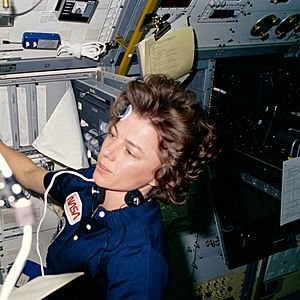
Some German scientists were worried about a woman being on the mission. Some experiments involved blood samples, and they hadn't planned for female blood. Also, some equipment didn't fit her. Bonnie reported this, and NASA made sure all equipment would fit a range of sizes.
STS-61-A launched on October 30, 1985, aboard the Space Shuttle Challenger. This mission had eight crew members, the largest crew to fly in space at that time. The crew worked in two shifts. Bonnie was in charge of the "blue shift." They performed about 75 science experiments. Bonnie's main job was to operate the Spacelab and its systems.
Challenger landed on November 6, 1985. The mission lasted over 7 days.
STS-32 Mission
After the Space Shuttle Challenger disaster in 1986, space flights were paused. Bonnie became the head of a NASA task force. This group looked at ideas for science experiments for the Space Shuttle and the planned Space Station Freedom.
On June 29, 1989, Bonnie was assigned to her second space flight, STS-32. This mission was also called the Long Duration Exposure Facility (LDEF) retrieval mission. The LDEF was a large satellite with 57 experiments. It had been launched in 1984 to study how space affects materials over a long time. By January 1990, the LDEF was losing altitude and was close to falling back to Earth.
The STS-32 mission launched on January 9, 1990, aboard the Space Shuttle Columbia. The crew deployed a satellite. Bonnie used the Canadarm (the shuttle's robotic arm) to grab the LDEF and bring it back. The crew also did many experiments. Bonnie was in charge of an experiment about microgravity.
Columbia landed after more than 10 days in space.
STS-50 Mission
NASA wanted to focus on materials science research for the Space Station Freedom. Bonnie Dunbar was chosen to lead the Microgravity Materials Research Task Group. She was also named the payload commander for STS-50. This mission, called the United States Microgravity Lab-1 (USML-1), focused on microgravity and materials science experiments. As payload commander, she organized the crew's schedule and training.
The STS-50 mission launched on June 25, 1992, aboard Columbia. Over 30 experiments were carried out in the Spacelab. For 13 days, the crew performed experiments on human body changes in space and how crystals grow in microgravity. They even had a microscope to watch crystals grow.
Columbia landed on July 9, 1992, after almost 14 days in space.
STS-71 Mission
In 1993, Bonnie Dunbar worked at NASA Headquarters. She helped make important decisions about redesigning the Freedom space station.
In December 1993, she returned to the Astronaut Office in Houston. She was asked to go to Russia as a backup for Norman Thagard. He was going to be the first U.S. astronaut to fly on the Russian Mir space station. This was a tough, year-long training program with no guarantee of a flight.
Bonnie had started learning Russian, but she wasn't fluent. However, NASA believed she could learn it, just like she learned German for a previous mission. She agreed. In February 1994, NASA announced that she and Thagard were chosen for the Mir mission.
Bonnie spent 13 months training in Star City, Russia. She found some Russian attitudes towards women challenging. But she made friends with Russian women engineers who supported her. She even enjoyed survival training for a possible landing in the Arctic. In March 1995, she was certified for long-duration Mir flights after passing many exams in Russian.
Even though she didn't fly a long-duration mission on Mir, her training was useful. She visited Mir on the STS-71 mission. Bonnie was a mission specialist on this flight. The mission launched on June 27, 1995, aboard the Space Shuttle Atlantis. This was the first time a Space Shuttle docked with Mir. Crews were exchanged, and a Spacelab module was used to check the health of the Mir crew. They studied how long periods in space affected bones, muscles, and other body systems.
The STS-71 mission lasted over 9 days. Atlantis landed on July 7, 1995.
STS-89 Mission
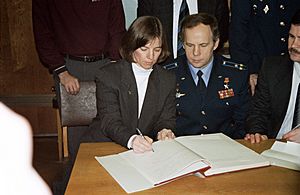
In January 1998, Bonnie Dunbar returned to Mir on the STS-89 mission. This mission launched on January 22, 1998, aboard the Space Shuttle Endeavour. It was the eighth time a Space Shuttle docked with Mir. The crew moved over 9,000 pounds of equipment, food, and water from Endeavour to Mir. An astronaut, Andy Thomas, was delivered to Mir, and another, David Wolf, returned to Earth. As the payload commander, Bonnie was in charge of 23 science experiments. Endeavour landed after almost 9 days in space.
Between 1995 and 1996, Bonnie worked on preparing for the International Space Station (ISS) and helping with Russian-American cooperation. She retired from NASA on September 30, 2005. She spent over 1,208 hours (more than 50 days) in space on her five flights. She also has many hours flying different types of aircraft.
After NASA
Leading the Museum of Flight
Bonnie Dunbar left NASA to become the president and CEO of the Museum of Flight in Seattle. She started the Washington Aerospace Scholars program. This was an online learning course for high school students, in partnership with NASA. She also expanded the museum's STEM programs, reaching almost 140,000 students each year. She helped expand the museum's collections and exhibition areas. She left the museum on July 1, 2010. She tried to get a Space Shuttle for the museum, but instead, they got NASA's Full-Fuselage Shuttle Trainer.
Teaching and Research
From 2013 to 2015, Bonnie led the University of Houston's STEM Center. She also taught engineering there. In 2016, she became a professor of aerospace engineering at Texas A&M University. She was also the Director of the Institute for Engineering Education and Innovation until 2020.
Personal Life
Bonnie Dunbar married Ronald M. Sega in 1988. He was an electrical engineering professor and was later chosen for astronaut training in 1990. They later divorced.
Organizations and Awards
Professional Groups
Bonnie Dunbar has been a part of many important professional organizations, including:
- American Ceramic Society (ACerS)
- American Institute of Aeronautics and Astronautics (AIAA)
- Association of Space Explorers (ASE)
- Society of Women Engineers (SWE)
- National Academy of Engineering (elected in 2002)
Honors and Achievements
Bonnie Dunbar has received many awards and honors for her work, including:
- Elected to the Astronaut Hall of Fame (2013)
- NASA Space Flight Medals (for each of her five missions: 1985, 1990, 1992, 1995, 1998)
- NASA Distinguished Service Medal (1996 and 1999)
- NASA Exceptional Achievement Medal (1994)
- NASA Outstanding Leadership Medal (1993)
- IEEE Judith A. Resnik Award (1993)
- Society of Women Engineers Resnik Challenger Medal (1993)
- Rockwell International Engineer of the Year (1978)
- She has also received many honorary doctorates from various universities.
See also
 In Spanish: Bonnie J. Dunbar para niños
In Spanish: Bonnie J. Dunbar para niños


